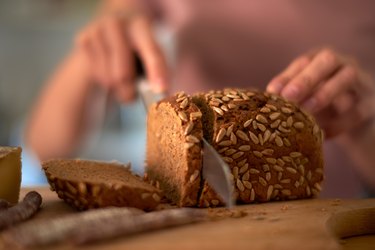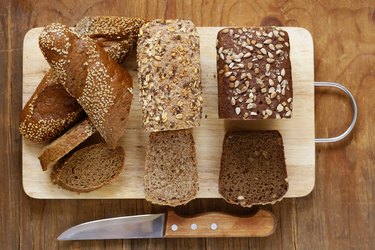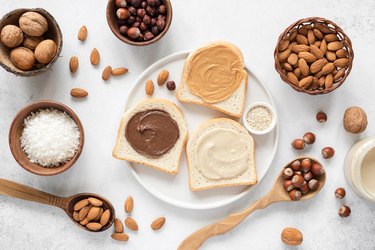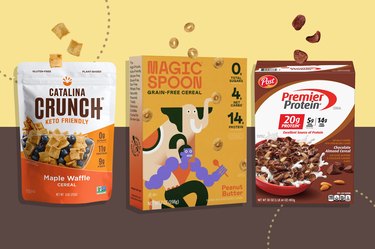
Want to experience the worst decision fatigue in your life? Step into the bread aisle of a grocery store and try to find the most nutritious loaf (it's no small feat).
With seemingly endless shapes, flavors and types, each promising its own health benefits, deciphering which loaf to toss in your cart can be draining. Read on to learn which bread is best and which to leave at the store.
Video of the Day
Video of the Day
The Best Breads
Let's get one thing straight: You don't need to be afraid of bread, says Bonnie Taub-Dix, RD and author of Read It Before You Eat It: Taking You from Label to Table.
Although bread may be thought of as a "bad carb," that's definitely not the case. But the type of bread you choose does determine how many vitamins and nutrients you're getting with each slice.
1. Whole-Grain and Whole-Wheat Bread
If you're in the market for nutritious bread, whole-grain is the way to go. Available in an array of colors, flavors and styles, whole-grain bread offers a higher nutritional value than most other types of bread, Taub-Dix says.
Whole Wheat vs. Whole Grain
Whole wheat and whole grain are often the same, Taub-Dix says. Whole grain refers to whole grains of an unspecified type, whereas whole wheat refers to whole-wheat grains. For both types of bread, though, double-check the ingredient list to ensure you're getting 100 percent whole grains.
Unlike refined varieties, this bread contains the bran, endosperm and germ of the grain's seed. That's where all the grains' vitamins and nutrients are stored, including B vitamins, magnesium, fiber, iron and protein, according to the Whole Grains Council.
Compared to refined grains, these nutritious carbs have been linked with reduced risk of type 2 diabetes and heart disease, per the Whole Grains Council. Whole grains may even help with weight maintenance and inflammation.
But the key to finding a good whole-grain bread is to look closely at the ingredient list, Taub-Dix says. Sometimes, bread packaging can list multigrain (more on that below), which isn't the same as whole grain.
Even the amount of whole grains can vary from bread to bread. If the ingredients list says "100 percent whole grain," then you can rest assured you're not getting any refined grains in your loaf, according to Harvard Health Publishing. But labels that say "made with whole grains" don't necessarily mean you're getting only whole-grain flour.
Whole-Grain Bread to Buy
- Nature's Own 100% Whole Wheat Bread Loaf ($3.39, Target.com)
- Arnold Whole Grains 12 Grain Bread ($4.24, Walmart.com)
- 365 by Whole Foods Market Organic Ancient Grains Bread ($3.99, Amazon.com)
- Dam Good Whole Wheat English Muffins ($19.50 for a 3-pack, Bubblegoods.com)
2. Sprouted Bread
Wondering what bread is doing in the freezer aisle? It's probably a loaf of sprouted bread. Because most sprouted breads are free of preservatives, they're kept frozen for freshness.
Most sprouted loaves are made without flour and instead use sprouted grain kernels, which have been baked into bread, Taub-Dix explains. Usually, these loaves will contain a bit more protein and less fat than other types of bread.
Sprouted grains may also have more available nutrients than mature grains, including folate, zinc, iron, vitamin C and magnesium, according to Harvard Health Publishing. But when you're buying a loaf of sprouted bread, you'll want to double-check that you're buying a loaf that's made with 100 percent sprouted grains to avoid any artificial preservatives or refined ingredients.
Sprouted Bread to Buy
- Food For Life Flourless Sprouted Grain Bread ($5.99, Amazon.com)
- Alvarado St. Bakery, Sprouted Multigrain Bread ($7.99, Amazon.com)
- Dave’s Killer Bread Organic Sprouted Thin-Sliced Bread ($5.47, Walmart.com)
The Case-by-Case
The nutritional value of these bread varieties really depends on the specific kind you're buying. These options are usually made with refined flours, which means they won't be too high in nutrients like fiber, iron and B vitamins.
But that doesn't mean you need to be afraid of bread, Taub-Dix says. It's OK to enjoy a slice of white sourdough or pumpernickel every so often. When you can, prioritize more nutrient-dense versions but don't banish the carbs you enjoy.
3. Enriched or Fortified Bread
If you or your family members don't enjoy the taste of a whole-grain bread, enriched or fortified breads make a good alternative, Taub-Dix says.
Enriched or fortified breads can help you get the nutrients and vitamins present in whole grains while avoiding the whole-grain flavor and texture. However, these types of loaves might not have as much fiber and protein — two nutrients that keep you fuller for longer — as whole-grain bread.
Enriched Bread to Buy
Dave’s Killer Bread Organic White Bread Done Right ($5.98, Walmart.com)
4. Multigrain Bread
Don't be fooled by similar names: Multigrain bread and whole-grain bread are not made equal. Multigrain bread can be whole-grain but that's not necessarily the case, Taub-Dix says. Multigrain simply means the bread is made with multiple types of grains — but these may be refined and stripped of nutrients.
"Multi means many; it doesn't necessarily mean whole-grain," Taub-Dix explains. "So even though multigrain sounds attractive, you should check that the first ingredient is whole grains."
Multigrain bread just may not contain as much fiber or nutrients as whole-grain varieties, Taub-Dix says. Considering fiber plays a role in keeping your blood sugar levels steady, you may not feel as full after a multigrain sandwich made with refined grains compared to a whole-grain version.
Multigrain Bread to Buy
- Brownberry Whole Grains Multi-Grain Bread ($5.69, Amazon.com)
- Dave's Killer Bread Organic 21 Whole Grains and Seeds ($19.95 per 2-pack, Amazon.com)
5. Rye Bread
Rye bread is made primarily of refined flour from the rye grain, Taub-Dix says. Although you can find whole-grain versions of rye bread, it depends on the ingredient list of your loaf.
Although darker breads, like rye and pumpernickel (more on that below) may seem more nutritious than lighter varieties, that's not always the case, Taub-Dix says. It all comes down to what's written on the packaging.
"Don't assume that the darker the color, the better the bread," she says. "Some breads are colored with molasses or coloring. A lot of people go by 'oh, I'm buying a dark bread' but that doesn't necessarily mean anything."
Again, look for "whole grain" on the ingredient list.
Rye Bread to Buy
- Dave's Killer Bread Organic Righteous Rye Bread ($14.99, Amazon.com)
6. Pumpernickel Bread
Pumpernickel bread, like rye bread, is often made with rye flour, which can be refined, whole or a mixture of both. Often, pumpernickel bread is heavier and sweeter than most bread types, which is why you may want to double-check the sugar content of the loaf you choose, Taub-Dix suggests.
"Sugar is also the master of disguise," she says. "It doesn't have to be spelled 'sugar' — it could come in the form of molasses, cane juice and high-fructose corn syrup. Sometimes, there can be more than one source of sugar in your bread without realizing it."
A good thing to keep in mind is that one packet of sugar has about 4 grams of sugar, Taub-Dix says. And generally, you want to stay under 24 grams (about 6 teaspoons) of sugar each day.
Pumpernickel Bread to Buy
- Mestemacher Natural High Fiber Bread ($14.39 per 3-pack, Amazon.com)
- Simple Kneads Gluten Free Pumpernickel ($6.65, Whole Foods)
7. Sourdough Bread
What exactly makes sourdough, well, sour? It's the fermentation of flour and lactic acid bacteria in the flour.
Unlike many other bread types, sourdough requires a starter, which is a combination of flour and water that has fermented over several days. But despite the sour taste, sourdough bread isn't that different from any other kind of loaf, Taub-Dix says.
Usually made with rye flour, sourdough is generally made of white flour unless you buy a specific whole-grain version or make your own.
Sourdough Bread to Buy
Bread Alone Organic Whole Wheat Sourdough ($6.99, Amazon.com)
The Least Nutritious Breads
Although these breads are often the least nutritious by themselves, they can still be part of a balanced diet. Many specialty breads are also part of different cultural cuisines, which means they shouldn't be neglected just because they may not be as nutritious as other varieties.
Bottom line: Enjoy these bread types in the company of a more nutrient-dense eating plan.
8. White Bread
White bread doesn't rank too high when it comes to nutrition. Unless you're specifically buying whole-grain white bread (which does exist, Taub-Dix says), it's safe to assume sliced white bread is low in whole grains and therefore nutrients such as vitamins, minerals, protein and fiber.
As mentioned above, it's OK to enjoy the bread that tastes best to you. As often as possible, though, try to pair a white bread sandwich with more nutrient-dense foods, like fibrous veggies and lean protein.
9. Specialty Breads: Ciabatta, Pita, Focaccia and Brioche
Most specialty-style breads, like ciabatta, pita bread, focaccia and brioche are made with refined white flour. Often, too, these breads are made with higher-fat ingredients like butter or eggs, Taub-Dix says.
Also, never assume that a specialty bread is gluten-free, she advises. As with all bread, you'll want to check for a gluten-free label on the packaging if you have gluten sensitivities or gluten intolerance.


